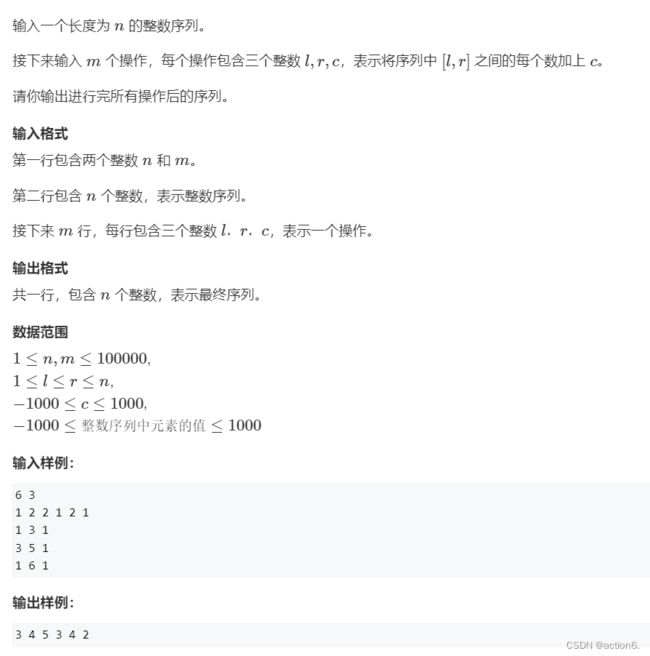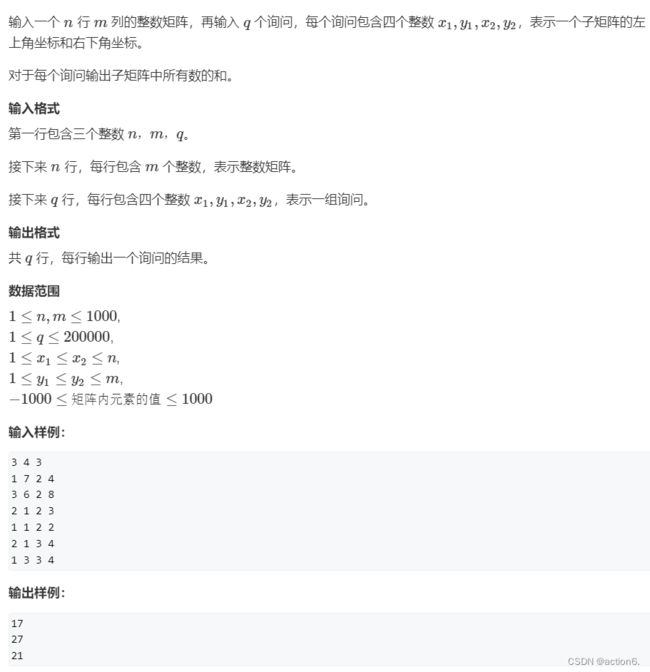前缀和与差分模板
前缀和O(1)
前缀和: 快速求出给定区间或矩阵的和
下标必须从1开始, 前缀和能在O(1)时间求出某个区间(一维)或子矩阵(二维)的和
一维前缀和:
s[i] = a[1] + a[2] + a[3] + … + a[i];
a[l] + … + a[r] = S[r] - S[l - 1]
#include
using namespace std;
const int N = 1e5 + 10;
int a[N];
int main()
{
int n, m;
cin >> n >> m;
for(int i = 1; i <= n; i ++ ) cin >> a[i];
for(int i = 1; i <= n; i ++ ) a[i] += a[i - 1];
while(m --)
{
int l, r;
cin >> l >> r;
printf("%d\n", a[r] - a[l - 1]);
}
return 0;
}
二维前缀和:
S[i, j] = 第i行j列格子左上部分所有元素的和
以(x1, y1)为左上角,(x2, y2)为右下角的子矩阵的和为:
S[x2, y2] - S[x1 - 1, y2] - S[x2, y1 - 1] + S[x1 - 1, y1 - 1]
#include
using namespace std;
const int N = 1010;
int s[N][N];
int n, m, q;
int main()
{
cin >> n >> m >> q;
for(int i = 1; i <= n; i ++ )
for(int j = 1; j <= m; j ++ )
cin >> s[i][j];
for(int i = 1; i <= n; i ++ )
for(int j = 1; j <= m; j ++ )
s[i][j] += s[i - 1][j] + s[i][j - 1] - s[i - 1][j - 1];
while(q -- )
{
int x1, y1, x2, y2;
cin >> x1 >> y1 >> x2 >> y2;
printf("%d\n", s[x2][y2] - s[x2][y1 - 1] - s[x1 - 1][y2] + s[x1 - 1][y1 - 1]);
}
return 0;
}
差分O(1)
一维差分:
差分简介:
差分:快速求出给定区间或矩阵+c的后的值
若有原数组 a1 , a2 … an
则需要构造的目标数组为b1,b2, …bn
使得ai = b1 + b2 + …+ bi
那么就称a数组是b数组的前缀和,b数组是a数组的差分
给区间[l, r]中的每个数加上c:B[l] += c, B[r + 1] -= c
acwing797. 差分

要在a[ l~ r ]中的元素全部加上C, —> al + C , al+1 + C ,… , ar + C
那么只要在bl+C后,则al后的所有元素都会加上C, 因为在求前缀和的时候bl一定会被遍历到
因此只要让bl+1 + C, br+1 - C
#include
using namespace std;
const int N = 1e5 + 10;
int a[N], b[N];
int n, m;
void insert(int l, int r, int c)
{
b[l] += c;
b[r + 1] -= c;
}
int main()
{
cin >> n >> m;
for(int i = 1; i <= n; i ++ ) cin >> a[i];
//将原数组加到差分数组里面去, 构造差分数组
//先假设a数组初始时全部是0,那么b也全部是0, 然后进行n次插入操作
//把每个元素都看成是区间长度是1的线段,那么在该点插入与该点的下一个点删除,则刚好能构成差分数组
for(int i = 1; i <= n; i ++ ) insert(i, i, a[i]);
while(m -- )
{
int l, r, c;
cin >> l >> r >> c;
insert(l, r, c); //在目标位置完成插入删除操作
}
for(int i = 1; i <= n; i ++ ) b[i] += b[i - 1];
for(int i = 1; i <= n; i ++ ) cout << b[i] << ' ';
return 0;
}
二维差分:
与一维差分类似,不过是在特定的矩阵中二维考虑如何进行构造差分数组的操作
假设左上角的下标是(x1, y1),右下角的下标是(x2, y2)
那么在(x1, y1)+C后,该点右下角所有的元素都会加+C
因此还需要将S1,S2和S3的元素减掉即可

b[x1,y1] += c; //算出来x1,y1右下角所有加过C后的值,但现在只需要操作x1,y1到x2,y2的值,为保证其余数据保持不变,就要对S1,S2和S3进行处理
b[x2+1,y1] -= c; //减去s1和s3
b[x1, y2+1] -= c; //减去s2和s3
b[x2+1,y2+1] += c; //发现S3被减了两次,加上即可
acwing798. 差分矩阵
#include
using namespace std;
const int N = 1010;
int a[N][N], b[N][N], n, m, q;
void insert(int x1, int y1, int x2, int y2, int c)
{
b[x1][y1] += c;
b[x1][y2 + 1] -= c;
b[x2 + 1][y1] -= c;
b[x2 + 1][y2 + 1] += c;
}
int main()
{
cin >> n >> m >> q;
for(int i = 1; i <= n; i ++ )
for(int j = 1; j <= m; j ++)
cin >> a[i][j];
for(int i = 1; i <= n; i ++ )
for(int j = 1; j <= m; j ++ )
insert(i, j, i, j, a[i][j]); //与一维相似,构造差分矩阵
while(q --)
{
int x1, y1, x2, y2, c;
cin >> x1 >> y1 >> x2 >> y2 >> c;
insert(x1, y1, x2, y2, c);
}
for(int i = 1; i <= n; i ++)
for(int j = 1; j <= m; j ++)
b[i][j] += b[i - 1][j] + b[i][j - 1] - b[i - 1][j - 1];
for(int i = 1; i <= n; i ++ )
{
for(int j = 1; j <= m; j ++ )
printf("%d ", b[i][j]);
printf("\n");
}
return 0;
}



